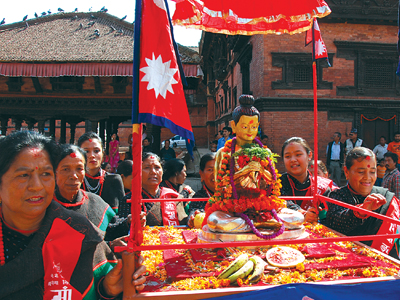Like many other groups use different calendars, Newars also follow their own lunar calendar, the Nepal Sambat.
Nhu Dan (the Newari New Year) falls during Tihar, the “Festival of Lights”. So, quite a lot of festivity usually marks its celebration. It may not be celebrated by screaming “Happy New Year” at midnight like people do on the New Year’s day of the Gregorian calendar or by visiting stupas and gompas like the Tibetans do during their new year – Lohsar. But it is celebrated with as much fervor, if not more.

A group of Newars participating in a procession of Sankhardhar Sakwha (who is believed to have established the Nepal Sambat) during ‘Nhu Dan’, the Newari new year
For Newars, this day signifies the beginning of a new dawn, a new dawn that all Newars hope will bring good luck, fortune and more happiness in their lives. In fact, Newars celebrate this day by performing the Mha puja, a prayer ritual for their own health and wellbeing. On this day, which usually falls on the 4th day of Tihar, or sometimes even coincides with the 5th day, the day of Bhai Tika (bhai: brother, tika: decorative ‘dab’ on the forehead), all the family members – from the youngest to the eldest – come together to perform this ritual.
Newars have been known to celebrate any festival or auspicious occasion in the grandest of manners. Nhu Dan is celebrated no differently. The rituals usually being as the darkness of night sets in just after twilight. And then amidst the glimmering diyos (special, small earthen oil-fed lamps) that are lit during Tihar, the Mha Puja begins.
It begins with mandaps being made on the ground for every individual member present in the family. The mandap is quite an intricate work of art designed with red and yellow colored vermilion powder with rice, wheat, marigold flowers incense sticks and camphor laid around it.
The ritual begins with the eldest female member of the house lighting the sacred lamp as a tribute to the gods. Then, each family member begins the process of worshipping and cleansing their own bodies and minds by lighting the ta. The ta, is indispensable to the ritual. Made of cotton cloth dipped in oil so that it burns steadily, it symbolizes the individual’s life. In the dim, burning light of the ta, each individual’s face lights up and the darkness is filled by the glow of the numerous tas. The ritual ends with the shagun – each consisting of a full-boiled (and then fried) egg, dried fish, a piece of meat, ginger and woh (fried ground lentil patties), which one has to finish before the ta burns out.
Nhu Dan is that time of the year when Newars reflect on what they have achieved in the year gone by, and hope for a better one ahead in which their past mistakes will be forgiven and forgotten and they can make a fresh start in their lives.











